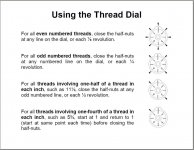Understanding the math would be preferable so that I can forego having to keep another piece of reference material in my tool box.

It's actually a really simple concept, and very easy to apply, it's just hard to wrap your head around at first, and a bit difficult to explain with only text, but here I go, this is how I look at it anyway.
Imagine if you were to lay the lead screw of your lathe and the work piece you are threading side by side on a bench comparing the threads' pitches. Obviously, if they were both the same pitch, all the threads would line up perfectly. If they were different pitches, you could line up one thread, but the next thread would be some amount off. But, because our thread system is based on number of threads per inch, as long as both threads TPI is a whole number, the threads will again line up exactly one inch from where you started.
For example, if your lead screw is 4 TPI, and the part your making is 5 TPI, center one thread at a zero mark, for the 4 TPI thread, the next thread will be at 1/4", the next at 1/2", then 3/4" then 1". Also for the 5TPI, the first at 0, then the next at 1/5", 2/5",3/5",4/5", and then at 1", the two threads coincide perfectly again. They will at every inch mark.
If you were cutting 6TPI instead, the two threads would coincide even more often. The first thread is at 0, then 1/6",1/3",1/2",2/3",5/6", and 1". So these two threads coincide every half inch as well as every inch.
The way this applies to your thread dial is in the idea that a thread dial is really nothing but a travel dial, except instead of showing your tools position relative to the bed of the machine it shows it relative to the lead screw. Most thread dials have the largest lines numbered, often 1,2,3,4. These USUALLY indicate one inch of relative movement of the tool to the lead screw per line.
First, check out your lathe. With the spindle off, move the carriage noting the distance it moves between lines of the thread dial. We need to know exactly how YOUR dial is graduated to understand exactly how your's is going to be applied. Most lathe makes use a similar system, but there are odd balls, so actually check it out on your machine!
Next we need to know how many TPI your lead screw is.
Once we have those pieces of info, we can determine what threads can be picked up at what positions.




